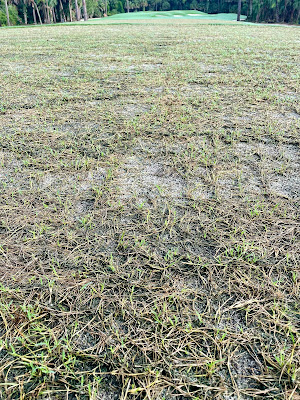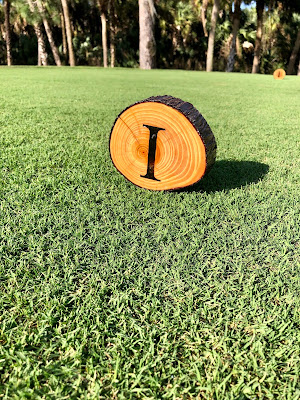Until the last two weeks the weather has been phenomenal for golf course construction. However, we knew it was inevitable that the Southwest Florida rainy season would arrive, and it has in full force!
Even with Mother Nature not fully cooperating the project continues to progress as planned. The first six holes (3-8) and the practice green area have been grassed, Better Billy Bunkers on these holes are complete, numerous ancillary projects are finished and the grow-in of the sprigged areas is underway.
 |
| Practice Green 6/26/21 |
Often when discussing the renovation project questions have arisen about the seeding of the golf course. The questions are understandable since when establishing cool season grasses (bentgrass, bluegrass, ryegrass, etc.) seed is a common planting method.
In Florida, we use warm season grasses (primarily bermudagrass) on golf courses. Without getting too deep into plant genetics, it helps to understand that only common bermudagrass is viable from seed. Common bermudagrass is a 36 chromosome plant, and while there have been some improved common varieties, in our situation they were not an option.
In analyzing our needs at Olde Florida it was decided that TifTuf, a hybrid bermudagrss was the best choice for our facilty. Hybrid bermudagrasses, like TifTuf were created to have improved golf and athletic field characteristics. In addition to TifTuf, examples of hybrids include; TifWay, TifSport, TifEagle, TifGrand, Latitude 36, as well as many others.
In laymen’s terms to create a hybrid bermudagrass a 36 chromosome plant (common bermudagrass) is crossed with an 18 chromosome plant (African bermudagrass) and what is produced is a plant that has improved attributes over each individually and is pollen and seed sterile.
Note: That is an extremely simplistic explanation of hybrid bermudagrass plant breeding.
If you are interested in a more detailed explanation on bermudagrass plant breeding you can click this link: "Dedicated plant breeders have worked for decades to improve common bermudagrass cultivars to provide finer, high quality turf."
Now that the plant genetic stuff is out of the way, let's talk "sprigging"!
Since hybrid bermudagrasses (like TifTuf) are sterile they can't be planted by seed. They are planted "vegetatively." This means they are established from sprigs or sod. One advantage of sprigging is it's much more cost effective than sodding. In fact, for every one acre of sod installed you could sprig 10 acres. When deciding how much, and where sprigs or sod should be used there are numerous factors, not just planting cost that must be considered
 |
| TifTuf Sprigs - 6/30/21 |
Sprigging is the process of removing stems (stolons or rhizomes) from a mature stand of turf and replanting the vegetative cuttings in a different location. All of our Certified TifTuf Bermudagrass sprigs (and sod) are harvested from Pike Creek Turf in Adel, GA. The turfgrass is harvested the day prior to the requested delivery date and transported overnight so planting can be begin at 7:00 a.m the day after harvest. This is very important! Successful establishment is highly dependent on the timing between obtaining, planting and watering.
 |
| Sprig Delivery #2 Fairway - 6/22/21 |
 |
| Sprig Delivery #2 Fairway - 6/22/21 |
Sprigs are typically 3 to 6 inches long and contain numerous nodes (i.e. growing points) from which new roots and shoots develop. Site preparation is critical to provide good sprig to soil contact and enhance establishment rate.
Our site preparation (after eradication of the existing turfgrass) included multiple vertical mowings, multiple aerifications at a 2" depth, sand top-dressing in wet areas and multiple circular passes with a UniRake to smooth the surface.
 |
| Sprig/Soil Preparation (Aerification) |
 | |
|
 | |
|
The final steps, which occur the morning of sprig installation is an application of an all organic pre-plant fertilizer, a "float" to smooth the surface and an application of a pre-emergent herbicide.
 |
| "Floating" 4 Fairway - 6/21/21 |
 |
| Pre-emergent Herbicide Application 6 Fairway - 6/24/21 |
Sprigs can be "hand planted" or "machine planted." Both methods are being utilized at Olde Florida. On our teeing surfaces, which have all been laser leveled to an exact 1% front to back slope, the surface is being hand planted and sliced in with a small tractor. The fairways and rough and being machine planted. Both methods broadcast the sprigs on the surface, followed by slicing/cutting in and rolling to smooth and seal the opening that was created in the soil.
 |
| Machine Planting 4 Fairway - 6/22/21 |
 |
| Hand Planting 3 Tee - 6/22/21 |
 |
| "Slicing" in 3 Tee - 6/22/21 |
It's essential that sprigs receive adequate water for best results during establishment. Sprigs are watered within 30 minutes of planting and we irrigate to keep the soil persistently moist during establishment. Sprigs must be watered generously during establishment because with limited roots the plant is unable to reach water in the soil profile. All sprigged areas are lightly irrigated throughout daylight hours for 7-10 days after planting.
 |
| Irrigation 4 Fairway - 6/22/21 |
The irrigation is a balance that requires continuous monitoring. We need to irrigate frequently enough that the sprigged areas do not dry out, but we also need to make sure the irrigation cycles don’t create washing of the soil or over saturate the area. The root system of a sprig also requires oxygen to function. This is where the "art and science" of turfgrass management is put to the test.
Irrigation is reduced gradually once the plants have established a root system and we see visible signs of growth. As the new turfgrass reaches 1-2" we will reduce irrigation during the day and move to a maintenance irrigation program of "deep and infrequent" nightly watering.
 |
| One Week Post-Planting 3 Tee - 6/29/21 |







